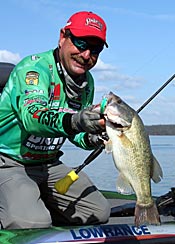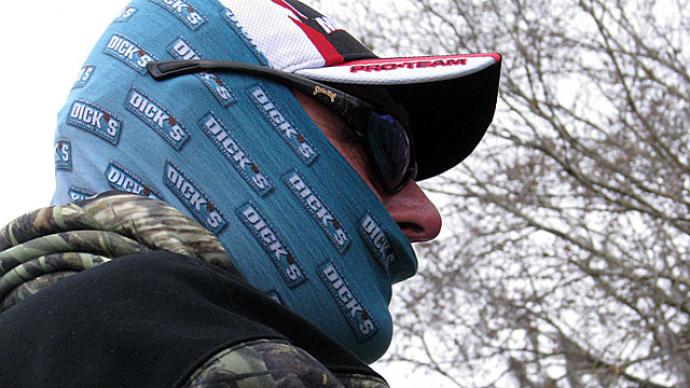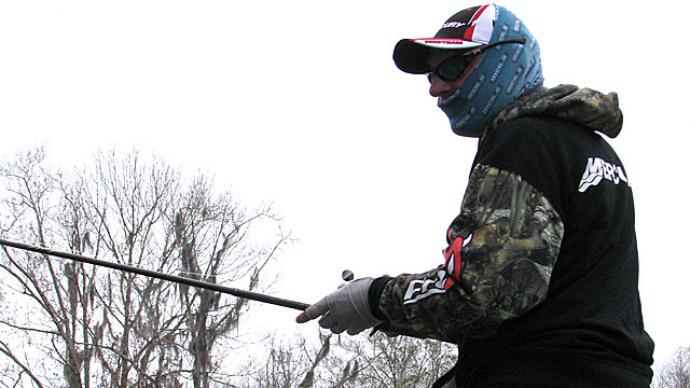
Keri May, co-owner of BassResource.com, spent a day on the water with Shaw Grigsby posing questions that members from our forums submitted for Shaw to answer. Here is part 7 of a nine-part series where Shaw answers every single one of them! In this episode, Shaw explains boat control, eliminating water, confidence baits, and more!
Keri: Outside bass from bass fishing, what's your favorite species to catch?
Shaw Grigsby: Tarpon.
Keri: Tarpon?
Shaw: Tarpon.
Keri: Never caught a tarpon.
Shaw: They're a saltwater called the Silver King. Where we fish from, they run from little guys, the 5, 10, and 15-pounders, but most of the ones we catch are 70-150, and I fly fish for them. I like that way of doing it, but any way of catching them is good, but fly fishing is just that much better.
It's just awesome. It's just an awesome, awesome fish. They're very acrobatic, so they get in the air. They're massive. You're talking about a fish that can tax you to the max. Take every bit of skill you have in fighting the fish, landing the fish, working the fish, getting them to bite, all that, and put it together on a fish that's 100-150 pounds. And it's sight fishing. To me, you're sight fishing doesn't get better. You're out there on the flats, looking for these fish, and you'll see them coming.
You'll often see them at 50, 70, 100 yards, and sometimes even 200 or 300 yards out you'll see them. You line up, and you get the boat positioned, and then with this giant fish swimming at you, you have to make the right cast, present it, work it right, get it hooked up, and watch it eat your fly. It's crazy; it's pretty awesome.
Keri: What about freshwater? Are there any other species?
Shaw: Peacock bass is probably as good as it gets, and smallmouth.
Keri: Yeah.
Shaw: The only difference between a peacock and a smallmouth, peacocks get bigger. We know how aggressive smallmouths are. Most people have caught them. They're really crazy. They're aggressive. They're all that. A peacock is that magnified by 5 times, 10 times.
Keri: Wow.
Shaw: A really great fish.
Keri: What's the biggest smallmouth you've landed?
Shaw: 5.14, I think, is my biggest.
Keri: What did you catch him on?
Shaw: A shaky head.
Keri: Really?
Shaw: Yeah.
Keri: Where at?
Shaw: Lake Michigan.
Keri: Oh yeah. There's some big smallmouth there.
Shaw: The next day, Earl did a show with me. He caught a 6.10. He caught five that were well over 25 pounds.
Keri: Holy smokes.
Shaw: It was like crazy good. He's a stunning angler. Everybody thinks of him as a boat racer, designer, and guy who made Stratus and Triton. He's a former tournament angler, and he's good. He's outstanding.
Keri: Can you talk to us a little bit about line? Was the question, do you ever use fluorocarbon for topwater?
Shaw: No, no, no.
Keri: No, no, no. Okay.
Shaw: No, no, no, and we had an angler on the Elite series win Oneida a couple of years ago that was using fluorocarbon on his topwater, but fluorocarbon line sinks. Top water doesn't help, it's going to drag your bait down, but he did it successfully. But no, I have when it's just been on the rod, and I looked around, and I didn't have any mono or anything on or braid. Braid is my preferred for topwater.
Keri: Really?
Shaw: I love it. You can make super long casts, and you have excellent hook-setting power. I love braid on a topwater bait. Then the next thing would be monofilament on topwater because it floats again, so you need something that won't sink. Monofilament does absorb after a bit, and it will sink a little, but it's still better than fluorocarbon, that's going to drag her down.
Keri: I never thought about using braid on top water.
Shaw: Especially on those big topwater baits, the big Zara Spook, Walk the Dog, stuff like that, it's just phenomenal what you can do, the power you have then when you get the bite. You can throw it out of sight, and that's a good thing, and then when you are that far out, fluorocarbon, of course, will sink, and then the bait will be bobbing out of the water, up and down type deal, but when you have braid it's on the surface and then get a strike way out there you get excellent hook set, a great deal.
Keri: So, talk to us a little more about that. Do you like fluorocarbon for any other situation?
Shaw: Worms, crankbaits, soft plastic, jigs, all that stuff. Now, if you're flipping in heavy cover, I'm using braid again, but I use fluorocarbon more than I do anything. Braid is probably second, and monofilament is last now. It used to be all you did was use mono-filament. That's probably one of the things when you asked something I do. I don't use monofilament that much anymore. I do a little, but it's not nearly what I do with braid and fluoro.
Keri: That's what I found interesting. One of our members was reading that you're able to catch larger fish on a spinning reel by reversing the crank of the reel instead of messing with the drag.
Shaw: Yeah, it's called back-reeling.
Keri: How did you come to figure that out?
Shaw: Back in the old days, we had crappy spinning reels. I'm not saying they were crappy, but they had crappy drags. Those old Zebco Cardinal 4 and the Mitchell 300s and all those types of things that were old ancient spinning reels, and they were excellent quality. They still work today, but their drags, drag washers, and stuff were very suspect. You'd hook a fish and rely on the drag, and they'd break you off. The drag would lock up, and you'd lose a big one, so you learned quickly that you needed to do something.
Doing that, it's back-reeling. So you'd leave it off the anti-reverse so it can spin freely, you set a hook, and when the fish runs, you can just let the handle go backward and spin backward, and then you can put whatever pressure you want on it. Let's say you're using 10-pound test, and you've got a drag that's set at 7 or something like that. So you're never going to stress the line enough to break it.
It's one of those situations where you can put pressure on him, but when he's running, you can back-reel, then you can get back on and reel. Whenever he slows up, you can keep constant tension, whereas, with a drag, they're more of a zzz-zzz-zzz, So it's a hit-and-miss deal.
Nowadays, our drags are spectacular. But once you learn to back-reel, you'll do it forever because it's that efficient. It's very good and very efficient, and you can manage a big fish very well, because a big fish, you can't do anything when he's running, especially on light line. So you let him run, just back-reel, two pounds of pressure or less, and then he starts to slow down, you can put all the pressure on them.
Now he's expended his energy, or she has, big female, expended her energy running, and then when she's kind of resting, you're dragging her right back to you, and so you're kind of keeping her off base right then. Then she expends her energy again, and you're just letting her go, and you bring her back to you again, and you end up wearing down a big one very rapidly. I won many tournaments on 8 and 10-pound test on spinning reels and catching 7, 8, 9, 10- pound fish.
Keri: How long would you say it took you to perfect the technique?
Shaw: Not long at all.
Keri: Really?
Shaw: Yeah. I actually have it down now where I don't even touch the handle. Most people would try to hold onto the handle back-reeling. I put my finger down on the bail head, let it spin backward, and pick it back up. It's pretty simple; any two-year-old can do it with about 20 years of experience.
Keri: Some members would like some tips on boat control and positioning. It's a tricky question, but any advice would be great.
Shaw: Sure. Keep it where you can cast, pitch or flip, or whatever you want to cast to.
Keri: It's an open-ended question.
Shaw: The bottom line is there is something to running the boat. The real key that I've seen, and I think it's unique in that I have a unique position. Not only have I been the angler, but I've also set back and done television commentary at the Classics. I did it for quite a few years, and I did the On The Water color. And to watch other anglers move down a bank and fish and pick out places to cast, and I'm looking at a piece of structure, and I'm going, I know he's going to hit that because there will be a fish there. He doesn't even make a cast at it. The angler goes by and doesn't even make a cast.
What's he thinking? What's in his mind that tells him not to cast there? Boat positioning is some of it, but choosing the right thing to cast at and knowing where your primary opportunity to catch one will be. These little cuts in the bank here. If they're not there, they might be right in the middle of the thickest stuff. So there's my stuff in the thickest stuff. So trying to figure out where they are and positioning and that type of thing is essential. Where boat control and positioning is just keeping it slow and easy.
Suppose you can go into the wind rather than with the wind. The wind pushes you like if you catch one, it pushes you on top of the fish. Into the wind, you let your foot off the trolling motor, and you drift backward away from what you just caught, and you're much more likely to pull back up there and catch another fish.
Any time you can go into the wind, with the exception of when it's really brutal, then you obviously can't, that's always a plus. Then keep it slow and easy with whatever presentation you're using. If you're casting, make sure that you're not having the stress on your cast and that you're within your range so you can be accurate. If it's crystal clear water, maybe it's how far away you can cast. Crystal clear means that the farther away you cast, you can have a little bit more success.
It's all just a little relative. It's like a little chess game. You put this piece here and that piece there like a puzzle until it all fits together to make the right combination, and then you're good to go.
Keri: Every time we do one of these, somebody always asks, how do you eliminate water?
Shaw: Just don't fish it.
Keri: That's a great answer.
Shaw: We do it as methodically as possible. I learned from Gary Klein back in 19..... A bald eagle, a big bald eagle. See that big, giant bird up there on the tip of that tree back there?
Keri: Oh, wow. Yeah.
Shaw: That's a big old bald eagle. That's a long way away, and he is that big. That's huge. A big old white head sticking out against the sky.
Keri: Isn't that beautiful?
Shaw: It would be good if you had a blue sky. You'd really be able to see that white head, but with the whitish clouds behind it, you can see it when he turns it. When he turns, it left and right. It's pretty impressive.
Keri: Great animals.
Shaw: Yeah, they are. They're just impressive, impressive critters. I learned it from Gary Klein, who said when you go to a new body of water. You don't know it, I asked him, as a Red Man all-American in 1985, I qualified again, and we were going out west to fish it, and I fished with Klein at the Hudson River, and I just asked him. I'm fixing to do this, and I've never been there. How do you go out there and figure things out? He said to take a section of the lake or a creek or something like that, something with a variety of stuff.
He prefers creeks, so you've got a section of the lake where you've got a creek bed and stuff like that where you can start and cover things quickly. So you cover the points like we just did. A point, now we're coming down inside the edge here, we're fishing the bank, we'll try some middle, we'll try a little bit of everything. Then you record and make that your body of water.
You don't go okay, I'm going to run here and check this, run here and check this, and I'm going to run there and check this because then you end up running a lot and you don't do a lot of fishing. You take one area with a lot of good stuff like a river arm, creek arm, or whatever, and you fish everything in that. Make it your whole lake for the day, that one little deal, and then every strike you get, you remember it, record it.
I used to carry a pocket tape recorder. There's another thing that I don't do anymore that I used to. I used to carry it and record every strike, and at the end of the evening, I'd lie down with it on my chest as I was going to sleep. I'd replay the whole day back, and it would just be minutes because you're just talking for a few seconds on this fish, a few seconds on that fish.
You would re-imprint everything, and you would develop patterns. You'd see I got one here that I didn't realize, so you'd usually pick up the primary pattern, what they were like on points or something or backs of coves or whatever, but then you'd always get a couple of bites, and you're going that's a secondary pattern. So that's another thing they're doing. You'd find another little pattern working out somewhere. So that would make a big difference.
So there's an excellent suggestion for figuring fish out is to take a small area, make it your lake, record all the strikes, figure out a pattern or two, and then apply that to the rest of the area, so that's kind of what we do in a nutshell.
Keri: So you've decided this is my body of water. This is what I'm going to fish. When do you decide it isn’t working and I've got to do something different?
Shaw: Generally speaking, in any section of water you're at, there's plenty of fish, and if you're not getting them, generally, you're not doing something right.
Keri: So how would you start changing that?
Shaw: Start changing baits. Like right now, I'm flipping a jig, and I'm pretty convinced I need to go slow because the water temperatures are cool and all that kind of stuff, and yet you've seen me pick up my crankbait a little, pick up my spinnerbait a little, flip and pitch a little. My primary is my jig. I feel confident that if I'm going to get a bite, I can get it on a jig. If it's cold, I can get it on a jig. If it's warm, I can get it on a jig. So I'm okay sticking with it, and it's pretty much black and blue. I can't go wrong.
In doing something like that, you have to start eliminating things, and if you're going a long time and you're not getting any bites, you've got to learn you've got to slow down, speed up, try something different, and then if you're still not getting them, you can change. Some conditions can dictate that that area of the lake doesn't have anything, whether it's cold or hot, but it's really cool.
I used to go to Rayburn. I won three BASS's on Rayburn in the spring, and I remember one of my earlier tournaments when I struggled on Rayburn. I looked everywhere. I ran all over the lake, looking for warm water. That's what I wanted to find. It was about this time of year, late February or early March, and I was looking for something. I finally found one cove that had 60-degree water and found fish in it. It was the warmest one I could find.
I got paired with George Cochran, and I drug him in there, and he whacked them. But I knew what I was doing. I looked for that. What was interesting was Clunn whacked them, Clunn destroyed them and caught a big sack, and he was running around finding the coldest water on the lake.
Keri: Oh, go figure.
Shaw: Because he knew there would be pre-spawn, and he would have some big fish. I'm looking for the warmest, and most of the field was looking for the warmest, so you look at things, and no matter what situation you're in, there's fish there. It's just a matter of figuring them out, getting things, and working on them. My suggestion is you can have a situation where something odd is going on, like that hot water discharge, and you don't know what's coming out of that plant.
You don't know what's creating that situation. Maybe there's no oxygen. I don't have an oxygen meter here, so I can't do it. You have to try enough different things to figure out what they're doing.



